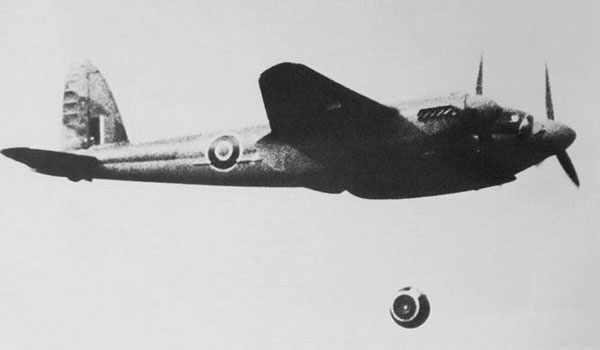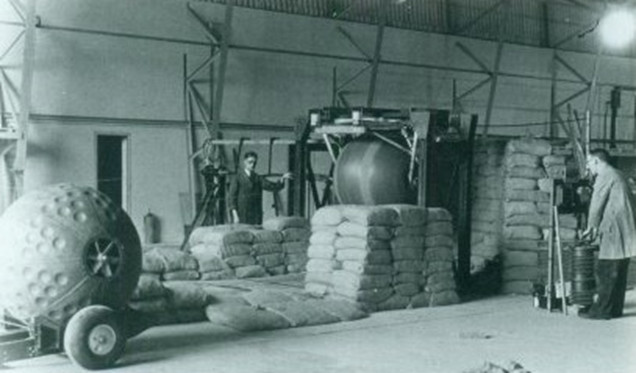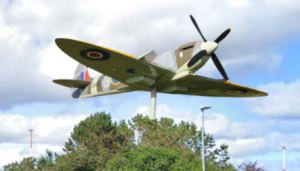Site 12. Operation Servant
On April 1st 1943 No.618 Squadron was formed at RAF Skitten. It was made up of crews from Bomber Command Squadrons 105 and 139, and Coastal Command Squadrons 143, 235, 236, 248, and 521. The sole purpose of this squadron was to attack the German battleship Tirpitz using an experimental and top secret type of bouncing bomb. Codenamed Highball, it was designed by Barnes Wallis as a smaller version of the now well-known Upkeep bouncing bomb. Upkeep was used by 617 (Dam Busters) Squadron for Operation Chastise in 1943 which targeted 6 dams in Germany’s Ruhr Valley.
Like Upkeep, Highball was intended to bounce across the surface of the water until it hit the ship, roll down the ship’s side and explode below the waterline. Unlike Upkeep, which was cylindrical, Highball was spherical.
Before release, the bombs weighing 1,280 lb (580kg), were spun backwards at 700 to 900rpm using a ram air turbine mounted in the bomb bay’s mid-section and fed from an extendable air intake. This backspin caused the weapon to bounce when it hit the water and skip across the surface. For the bombs to work correctly they had to be dropped from a height of exactly 60 feet (20m) and at a speed of 360mph (600km/h).
The aircraft selected to carry Highball was the Mosquito Mk.IV which was modified to enable it to carry these bombs. This entailed removing the bomb bay doors and fitting special carriers to carry two Highballs in tandem.

The operation, codenamed Servant, was timed to take place on May 15th 1943. It was recommended the crews have at least 2 months of specialist training before any attack was launched. However, as the squadron had only been formed on the 1st of April this gave the crews barely 6 weeks to prepare.
Operation Servant was given the highest security classification, and 618 Squadron itself was a ‘Top Secret’ squadron. Any mention of this operation was to be excluded from the minutes of meetings of the Chiefs of Staff of the air force and navy.
At RAF Skitten strict security measures were put in place. The area of the airfield to be used by the squadron was cordoned off and access was controlled by the RAF Police. Special passes were needed to access the area. The windows of the airfield’s Operations Room were sealed up and stronger doors fitted to upgrade the security. Any discussion of the operation was forbidden outside the Operations Room.
As personnel and modified Mosquitos began to arrive at RAF Skitten the aircrews began familiarising themselves with the aircraft and the low-level flying techniques that would be required for the operation.
The Mosquitos that were to carry the bombs, which were always referred to as ‘stores’, started to arrive on the 17th of April. Low-level high-speed attacks were practised on the Bonaventure, an old depot ship moored in Loch a’ Chàirn Bhain on the west coast of Sutherland near Kylesku, while other Mosquitos based at RAF Turnberry tested the Highball against the old French battleship Courbet in Loch Striven.
Despite the squadrons preparations, problems and delays with Highball itself meant that the target date was missed. It was recommended that Operation Servant was undertaken before the end of June while the Tirpitz was still anchored in Trondheim Fjord in Norway. However, more problems with both Highball and its release mechanism meant that this date was also missed and with it the realistic possibility that the operation could proceed at all.

In early September 1943 Operation Servant was officially abandoned and some of the squadron was posted to RAF Wick to carry out other special duties. The remainder of the squadron was eventually moved to Australia where they continued the development of Highball for use against Japanese ships. Despite all the effort put into the development of Highball it was never actually used in anger.
On November 12th 1944, during Operation Catechism, 31 Avro Lancaster’s from 9 and 617 Squadrons each loaded with a single 12,000lb (5,400kg) Tall Boy bomb attacked the Tirpitz as she lay at anchor next to Håkøya Island in northern Norway. Several bombs exploded on or near the ship and she capsized and sank in 11 minutes with the loss of nearly half her crew. Sources vary but this was between 950 and 1,200 men which was a great loss to the Kriegsmarine.


